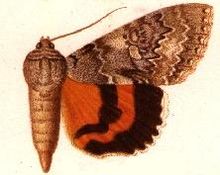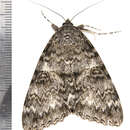Conservation Status
provided by University of Alberta Museums
A common, widespread insect. No concerns.
- license
- cc-by-nc
- copyright
- University of Alberta Museums
Cyclicity
provided by University of Alberta Museums
Adults are on the wing from late July through September.
- license
- cc-by-nc
- copyright
- University of Alberta Museums
Distribution
provided by University of Alberta Museums
From Newfoundland west to south central British Columbia, south to Kentucky and Missouri in the east, Colorado and Utah in the west. In Alberta, it is most abundant in the Cypress Hills, the Aspen parklands and the southern Boreal forest, but also present in the cottonwood stands along the rivers on the southern plains, and throughout the foothills and lower elevations in the mountains.
- license
- cc-by-nc
- copyright
- University of Alberta Museums
General Description
provided by University of Alberta Museums
"A large (6.8-8.2 cm wingspan) moth with dark mottled grey forewings and dark red-orange hindwings, crossed by a broad black median band and a wide black terminal band. Unijuga is the largest and one of the most widely distributed of the Alberta Underwing moths. The dark red-orange (as opposed to pink) hindwings with wide black bands will separate it from all Alberta Catocala except meskei and briseus. Meskei is smaller, usually has paler and less mottled forewings and brighter red hindwings. There is also usually a small black spot at the lower end of the black median band on the hindwings, or a small upturned extension to this band. Meskei also lacks the many dark hairs in the basal area of the hindwings which give unijuga a darker, duller appearance. Briseus is smaller than unijuga, and has darker forewings with a characteristic prominent lighter patch with brown scaling on the outer half.
A form of unijuga with the forewings sooty black and with the markings reduced to traces of the jagged white subterminal line (form agatha) is not uncommon in Alberta."
- license
- cc-by-nc
- copyright
- University of Alberta Museums
Habitat
provided by University of Alberta Museums
Mature poplar and mixedwood forest, in particular older aspen poplar forest.
- license
- cc-by-nc
- copyright
- University of Alberta Museums
Life Cycle
provided by University of Alberta Museums
Adults are nocturnal and come to light, but they are best collected with sugar baits. The adults emerge in late summer and early fall, and the eggs overwinter. The larvae, which are solitary defoliators, hatch in May and can be found until early August. There is a single brood each year.
- license
- cc-by-nc
- copyright
- University of Alberta Museums
Trophic Strategy
provided by University of Alberta Museums
No Alberta data. Elsewhere in Canada reported to feed on poplars (Populus) and willows (Salix).
- license
- cc-by-nc
- copyright
- University of Alberta Museums
Catocala unijuga
provided by wikipedia EN
- license
- cc-by-sa-3.0
- copyright
- Wikipedia authors and editors
Catocala unijuga: Brief Summary
provided by wikipedia EN
Catocala unijuga, the once-married underwing, is a moth of the family Erebidae. The species was first described by Francis Walker in 1858. It is found in North America from Newfoundland west to south central British Columbia, south to Kentucky and Missouri in the east, Colorado and Utah in the west.

Illustration
The wingspan is 68–82 mm (2.7–3.2 in). Adults are on wing from July to September in one generation depending on the location.
The larvae feed on Populus tremuloides, Populus nigra and Salix species.
- license
- cc-by-sa-3.0
- copyright
- Wikipedia authors and editors


 Illustration
Illustration